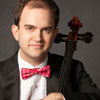
Joseph Mendoes grew up in Glendora, CA, a suburb of Los Angeles. He began his cello studies through his local public school program and continued with private lessons under Doris Savery. In High School he studied cello and chamber music with Dr. Richard Naill at the Colburn School of Performing Arts in Los Angeles, CA.
It was at this time he performed in master classes for Heinrich Schiff and Orlando Cole, and was a member of the Colburn Chamber Orchestra under the direction of the late pedagogue Daniel Lewis, whom he considers to be one of his chief influences. He also won numerous prizes for solo and chamber music performances, including the 1999 SYMF cello competition and a second place finish at the ASTA Southern California Competition.
He was awarded a scholarship to study with Ronald Leonard at the USC Thornton School of Music in 2000, and graduated with honors in 2004. During that time he performed frequently as a member of the Camden String Quartet. With the Camden Quartet he performed in master classes for the Emerson, Ysaye, Julliard and Guarneri String Quartets. The Camden Quartet was honored with the Chamber Music Award at USC in 2004. The Camden Quartet also won 1st prize at the Palos Verdes Peninsula Music Festival.
In 2008, he was selected to participate in the Naumburg International Cello Competition in New York City. From 2006 to 2010, he was a faculty member and performer at The Viola Workout in Crested Butte, CO. In 2011, he performed all of the cello sonatas of Beethoven in one concert. In 2014 he became the Cello Expert for Virtual Sheet Music, where he has published many educational videos about cello technique and musicianship. From 2012 to 2017 he taught cello at the community school division of the Colburn School of Performing Arts, where his students won several prizes and scholarships, including performances with the Inland Valley Symphony and the Las Vegas Philharmonic. From 2011-2017 he was acting principal cello of the Riverside County Philharmonic, where he performed the orchestral solos for many works, including the William Tell Overture by Rossini. In 2016 he released his first commercial recording, the complete works for cello and piano by Joachim Raff, to enthusiastic reviews. He currently lives with his wife, Jaimie Lee Mendoes, in south central Michigan where he teaches online lessons and works on various cello related projects.

